MetaMask is arguably one of the most well-known bridges for Web3 authentication and accessing Ethereum-based dApps. Those unfamiliar with the broader dApp ecosystem might simply know MetaMask as the browser extension that effectively functions as a cryptocurrency wallet. Nevertheless, MetaMask’s native authentication is what sets it apart. If you build your dApps, DeFi projects, or Web3 dApps with Moralis, you’ll get access to a next-gen Web3 development platform that provides fully managed, infinitely scalable blockchain backend infrastructure. Best of all, however, it also features full support for authenticating with MetaMask. As such, Moralis allows you to build a dApp and authenticate your users with MetaMask with ease. Read on to learn all about how to authenticate with MetaMask!
Before we go deeper into details on how to authenticate with MetaMask, we must answer what MetaMask is. Why, you ask? Knowing what MetaMask is and why it is necessary to use it allows you to understand exactly how to use it. You, as a dApp (decentralized application) creator, will learn how utilizing this tool is an essential part of building game-changing dApps. Moreover, we’ll take you through how to connect to and interact with Web3 applications using MetaMask.
Moralis provides a range of powerful features, including the Moralis Price API, the Moralis NFT API, Moralis’ Speedy Nodes, or Moralis’ Deep Index API. Nevertheless, Moralis’ MetaMask authentication features should not be overlooked when it comes to creating dApps with amazing user experiences. If you’d rather watch a video to learn about all the great features integrating MetaMask authentication with Moralis can bring, just watch the following video:
MetaMask Authentication Made Easy with Moralis
Before diving into the specifics of MetaMask and how to authenticate with MetaMask, let us look at why Moralis supports MetaMask authentication to begin with. Put simply, we want to help you as a developer to build the best dApps possible, quickly and efficiently. You will no doubt, when you start creating your next dApps, want your users to be able to authenticate themselves and sign in with MetaMask.
Performing a MetaMask login is something crypto users do on a practically daily basis. As such, it is absolutely vital that Moralis has native support for MetaMask when you build your dApps! Moralis is also completely serverless, and does all the heavy backend lifting for you! Now, if you decide not to use Moralis, you’ll have to run your own server and potentially your own node. By doing so, you’ll waste time and resources. As such, let’s get into the specifics of MetaMask and what it is!
What is MetaMask?
Although we’ll briefly explain whatt MetaMask is in this article, we also have a full article dedicated to this topic – so be sure to check out our in-depth “What is MetaMask” guide. There, you’ll take a deep-dive into the world of MetaMask, and its many different use-cases.
If you’re a newcomer to the blockchain or cryptocurrency industry, MetaMask might be something you have never heard of before. Maybe you found this article while researching crypto wallets, or general ways to authenticate on Ethereum or for Web3. Another possibility is that you want to build a dApp on the Ethereum network, but you require a way to validate users in order for them to use the application. If so, you’ve come to the right place! In fact, whatever your use-case might be, we’ll break it down in an easily understood way!
Characteristics of MetaMask
- Essentially, MetaMask is a cryptocurrency wallet that interacts with the Ethereum blockchain. You can run MetaMask as an extension or add-on to your browser. MetaMask can hold your cryptocurrencies and crypto-assets, such as Ether, or any other ERC-20 token. You can also use it to store non-fungible tokens, also known as NFTs.
- MetaMask is available as a mobile application.
- You can change different types of networks inside MetaMask.
- MetaMask allows you to interact with blockchain applications such as dApps and DeFi apps.
- MetaMask also serves as an authentication module that connects you, as a user, to your account and data. You’ll have keys you can use to interact, access, and transact. You have the power to choose what you can share and what you would like to keep private. MetaMask authentication is secure and reliable.
Why Should I Authenticate with MetaMask?
Web3 and decentralized applications are a crucial part of the future. This is something that’s also becoming clear to a growing number of companies. We’re currently living in a digital age where everything becomes increasingly accessible. A clear analog of why Web3 needs authentication like authenticating with MetaMask is the infancy of the Internet. Email and password authentication have been around since the 1990s, when people first began to use the internet. In essence, it’s easy to see why some could regard MetaMask as a more capable validation and authentication analog for Web3. This is, naturally, why Moralis is providing native support for Web3 authentication with the likes of MetaMask when you build dApps.
Additionally, MetaMask holds the keys on your device’s browser, rather than storing them on some remote server. MetaMask is also already hugely popular, as over five million people are already using MetaMask. That makes it one of the most popular online wallets currently available. There are other online wallets out there; however, our experience is that MetaMask is the go-to wallet if you’re interested in getting started with cryptocurrencies.
How to Authenticate with MetaMask
As we mentioned, authenticating with Metamask has never been easier than when building dApps with Moralis. The following segment will be a more technical tutorial, and we’ll show you how to create a server on moralis.io, what scripts are needed, and finally, how to authenticate with MetaMask. You will be able to follow along step-by-step, and in the end, you can run the authenticator on your own!
- What you’ll need to do first is go to moralis.io and sign up for free.
- As you’ve logged into your account, create your first server. Name it whatever you want. You can choose either the Mainnet, Testnet, or a Local Dev Chain. As seen in the example below, I’ve chosen New York as the Region, Mainnet as Network, and Ethereum as the blockchain.
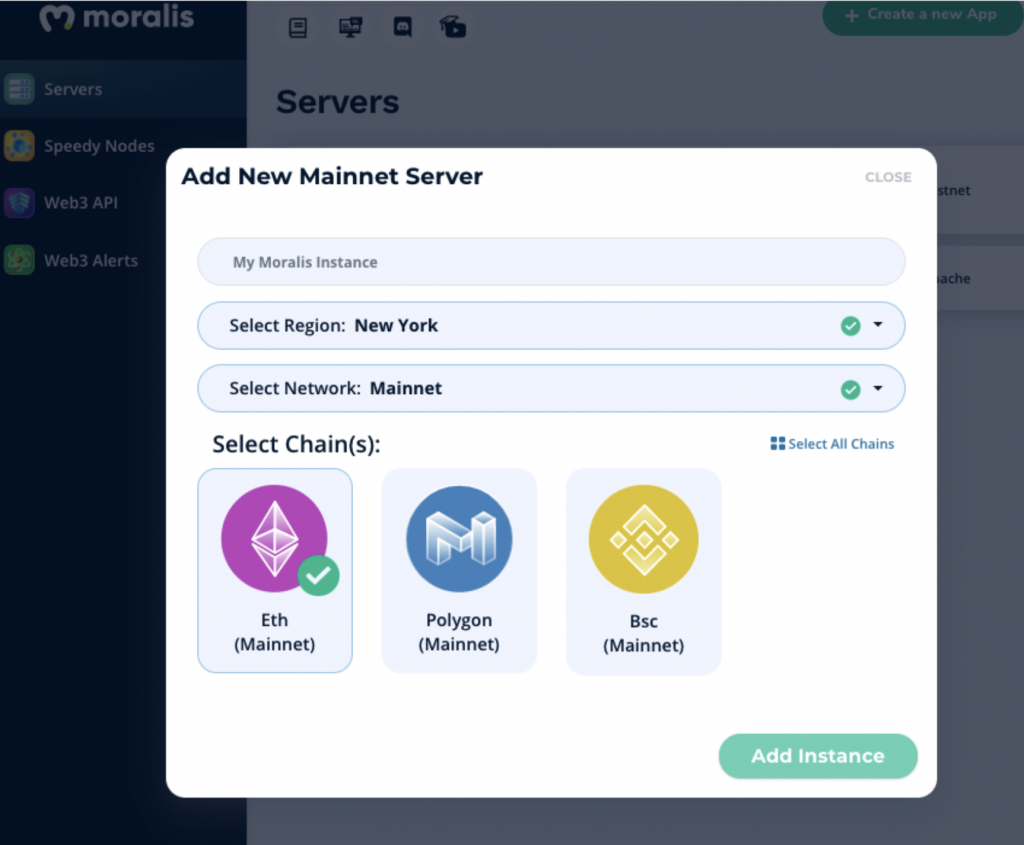
- Once this is complete, you can interact with your server. Starting up your server can take a while, so you can grab a cup of coffee in the meantime.
- Click on Dashboard.
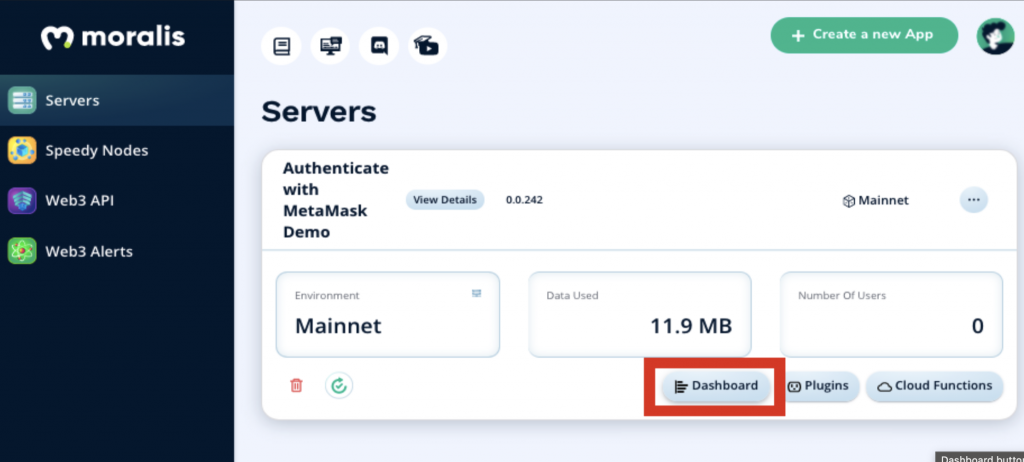
- You will see your dashboard with all the data (none in the beginning):
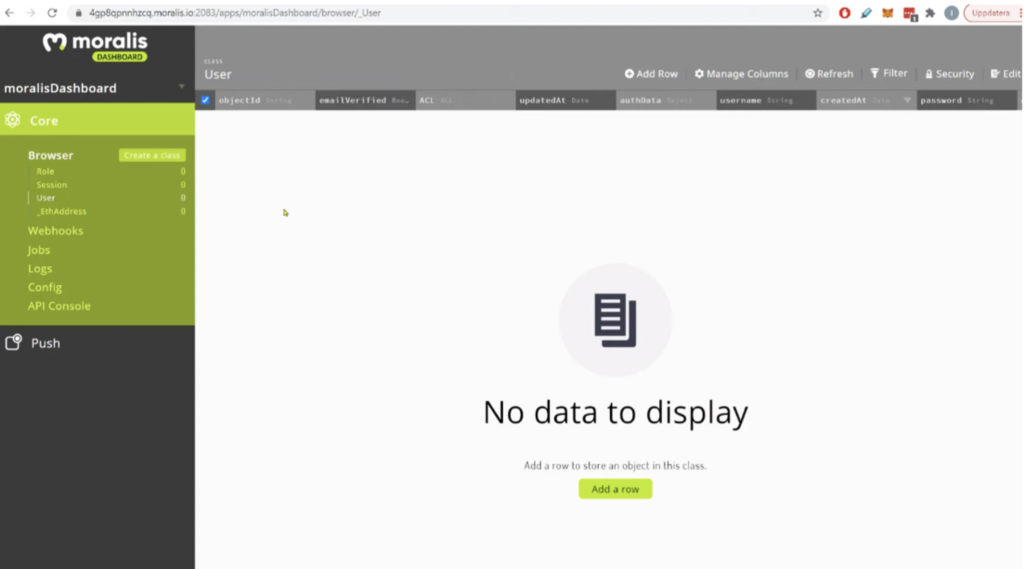
- Now, you have to add your code to authenticate the user to, later on, be added to the database. To make this work, you have to import a few scripts to your code. The following will show you two of the scripts you need. It is the web3.min.js and moralis.js scripts.
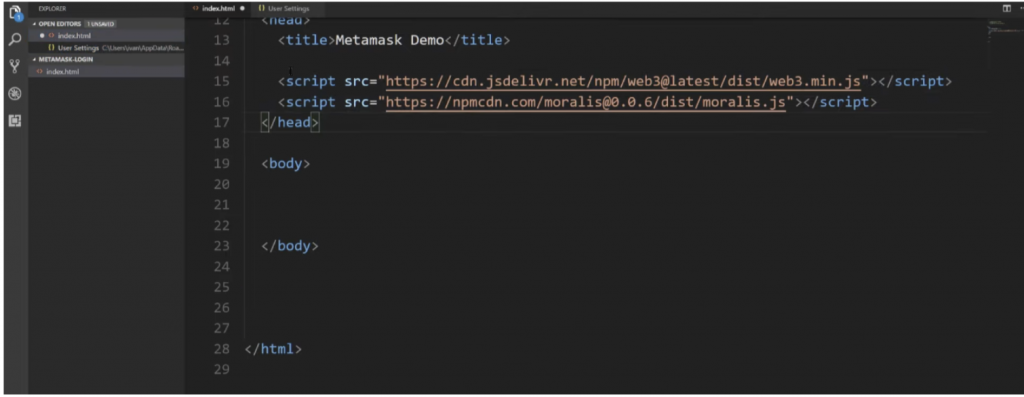
- Now we need to authenticate this with our server. Basically, we need to tell Moralis that we’re using the Moralis Server, and we need to tell it exactly which server we’re using. We need to insert a new script inside the <body></body> tags as shown below. As you can see, we have written Moralis.initialize and given it the application id, and we’ve also written Moralis.serverURL and given it the server URL:
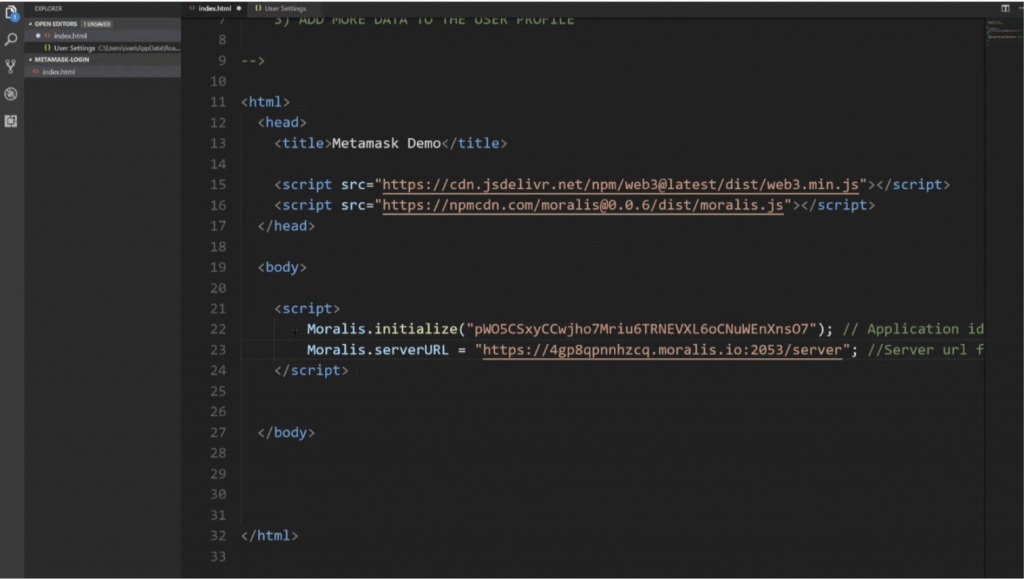
- How do we find the application ID and server URL? You have to go into your moralis.io login page, where you can access your server. On the selected server, click on “View Details.” There you’ll find the application ID and server URL. Now, you just have to copy and paste, super easy.
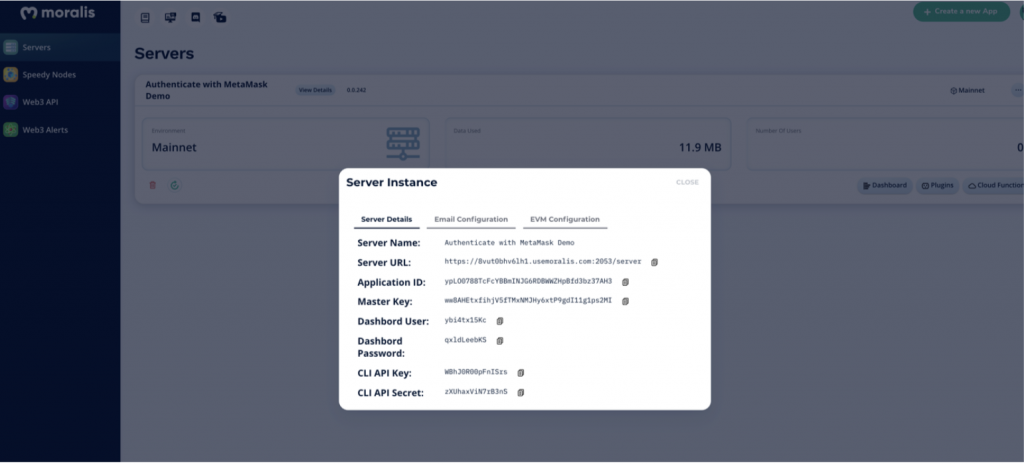
- What we just did, is just the beginning; we’ve got more code we need to insert, so stay patient. We now want to be able to authenticate, which is very simple to do. See the code below:
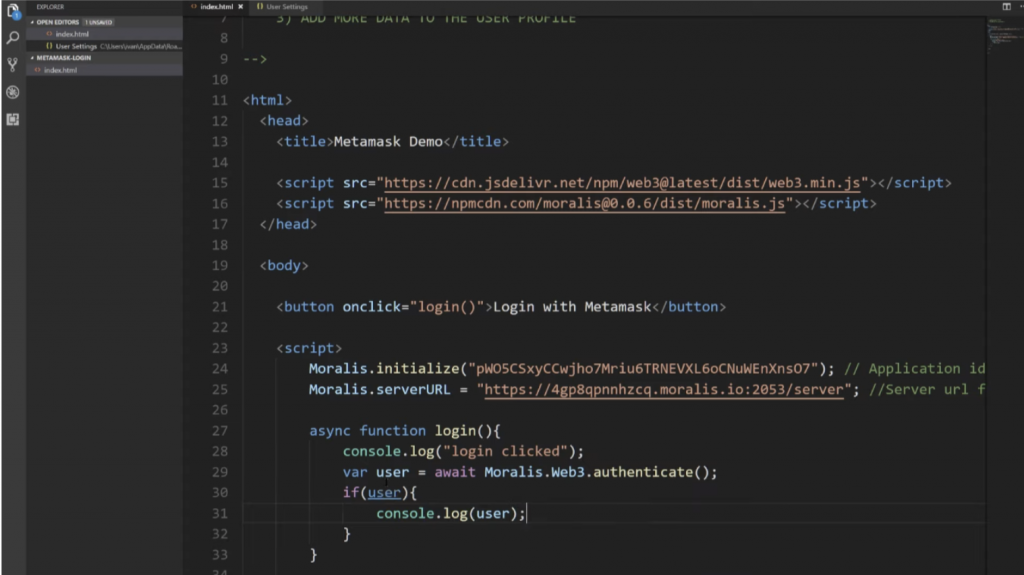
- This will enable a button and give the user a signature request. This means you’re signing a message to prove that you own the address.
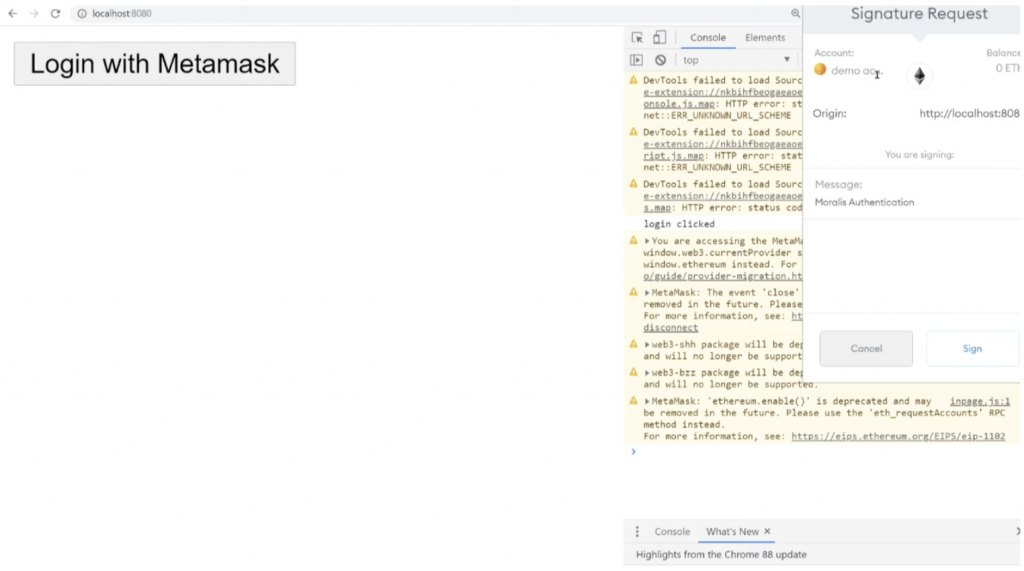
- You’re basically just signing a message here to prove that you own the address, which Moralis needs to know. In the following image, you can see that we get the user information:
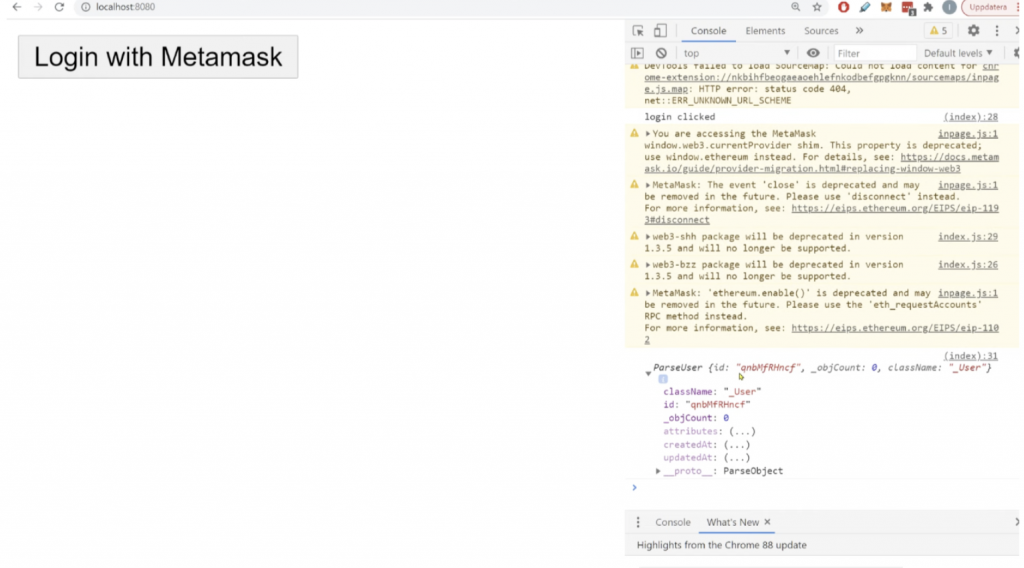
- If you go back to your user database, you can see the entry that we made. We have the signature information regarding address etc. With this information, we can add more info to the user, such as a nickname, favorite color, and you can assign an image, etc.
More MetaMask Use Cases
Of course, you can do many things with MetaMask rather than just using the authentication feature. It has many essential functions that you’ll discover with time. A really nice feature that is possible with the help of Moralis is merging two or several different MetaMask accounts. If you’ve used the extension, you know that you can have separate accounts on the same module. Many people use other accounts for privacy reasons. Now, if I have five different addresses, could it be possible to merge all of them? How can this even be done, you might ask? It’s simple, with two lines of code. We will not explain further in this article how to do this. There is a whole section about MetaMask in our Documentation and there are more YouTube videos that’ explain this in further detail. So, if you’d like more info, head over to docs.moralis.io or check out our YouTube channel for more.
How to Authenticate with MetaMask – Summary & Key Takeaways
We’ve now gone through how to use MetaMask as an authenticator. It can sometimes be a challenge; however, we are confident that you’ll succeed! With the Web3 gateway to decentralized applications, MetaMask is simply a “must have”. This is naturally why Moralis features native support for MetaMask authentication. The resources you’ve discovered so far and by inserting simple JavaScript using Moralis to get the authentication process working is just the tip of the iceberg. The Moralis backend infrastructure is capable of so much more! Web3 is the future, and with new things come new opportunities that’ll be possible with MetaMask.
As we mentioned at the beginning of this article, with help from Moralis, building and creating applications has never been easier. Hopefully, the example of how to authenticate with MetaMask using Moralis has given you some more insight and shown you the simplicity of how easy it is to use Moralis and simple JavaScript. Of course, there is so much more that you can do. The blockchain and Web3 space is enormous! What you’ve learned is just the beginning of your amazing blockchain journey. If you are indeed a newcomer to the blockchain industry or even if you are a rookie and are wanting to learn more about building and creating Web3 apps, then Moralis is the place to be. Supercharge your dApp development by using Moralis today, for free!
